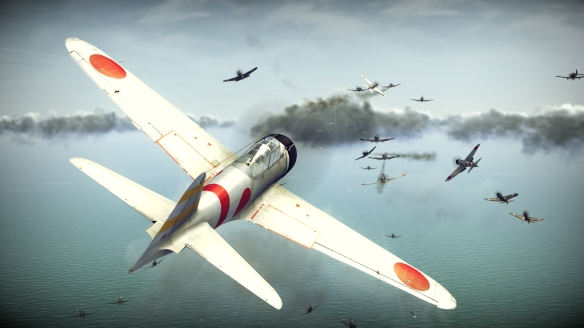Never believe loss/kill ratios: Overclaiming in combat seems to be part of human nature. For well-trained allied pilots the number of kills probably was on average only 50% of that claimed; the Japanese overclaimed by larger factors.
It is very difficult to counter ‘hit and run’ tactics, more usually called today (i.e. since the Vietnam war) ‘energy fighting’, and generally characterized by maneuvers in the vertical, instead of the horizontal, plane. The idea is to conserve the amount of energy of the fighter, in the form of speed (kinetic energy) or height (potential energy). Tight turns, on the other hand, ‘bleed’ energy. Energy is so important that a fighter in a low energy state is quite unlikely to catch one in a high energy state, unless the enemy pilot blunders. In such conditions, acrobatic maneuvers are not a real counter in the sense that they offer an equal chance of winning: It is left to the other pilot whether to accept these terms of combat (which is usually wrong, as they are disadvantageous for him) or simply refuse to engage in a turning fight, and maneuver to win a new attack position.
In that sense, the Japanese did modify their tactics. At the beginning of the war the Japanese navy used its own version of ‘energy’ tactics, exploiting the A6M’s speed and high rate of climb (a very useful tactics against the F4F and especially the F2A). As the American fighters became better, they had to switch to a ‘turning’ style of fighting. They were not blind to the disadvantages of the A6M and Ki-43, but were unable to replace them entirely with better fighters.
You also have to consider that at the time of ‘Marianas Turkey shoot’ many Japanese pilots were so under-trained as to make the issue of tactics irrelevant, and heavily outnumbered. Guadalcanal was probably the last battle the Japanese could fight with a sufficient cadre of trained pilots. From there it went downhill. As long as Japanese pilots had reasonable training, the loss/kill ratios were less biased against them; but the Americans could replace their losses and the Japanese could not. The Americans of course had an additional factor in their favor: Their aircraft were far more rugged and more likely to survive combat damage.
Finally, it is worth remembering that air combat was not the only cause of loss, on both sides. The Americans claimed the destruction of 2140 Japanese aircraft by the F4U for an own loss of 189. But they also lost 349 to AAA, 164 in training accidents, and 992 to ‘other causes.’
